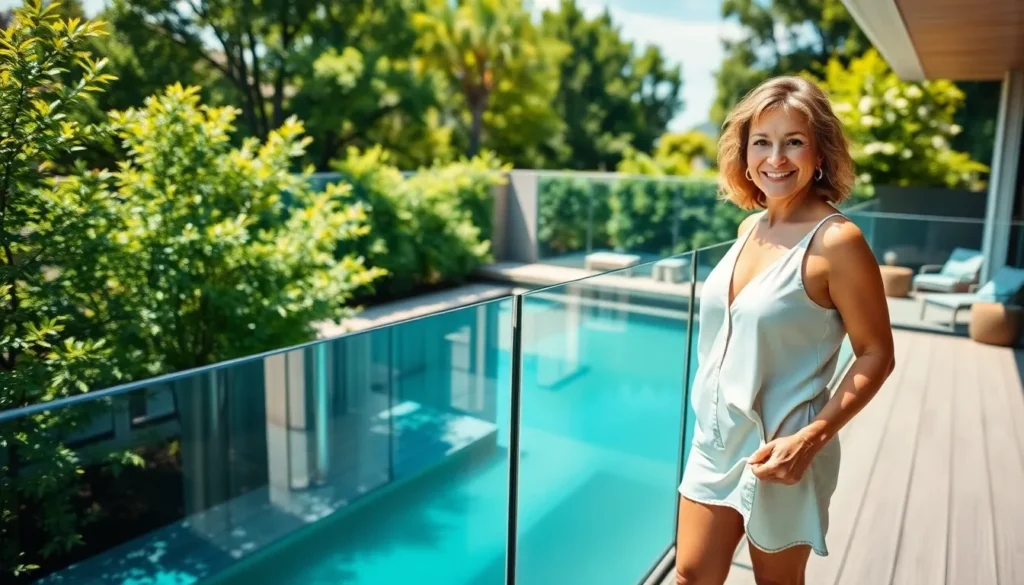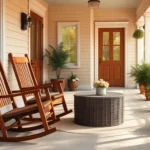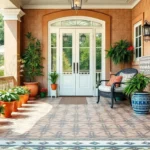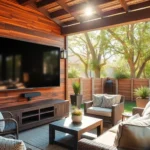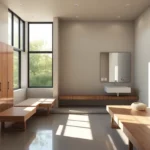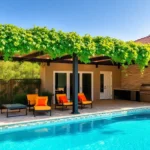Creating the perfect pool deck railing transforms your backyard oasis from ordinary to extraordinary. We’ve all seen those stunning poolside retreats that make us wonder what sets them apart – and often it’s the thoughtful railing choices that create that magazine-worthy look.
Safety meets style when you choose the right pool deck railing system. Whether you’re dealing with elevated decks or simply want to define your pool area, the railing you select becomes both a protective barrier and a design statement that reflects your personal taste.
We’ll explore innovative railing ideas that blend seamlessly with any architectural style while meeting local safety codes. From sleek glass panels that preserve your view to rustic cable railings that add modern flair, there’s a perfect solution waiting for your space that’ll have your neighbors asking for design tips.
Classic Glass Panel Railing Systems
Glass railings create an unobstructed view of your pool area while maintaining essential safety barriers. These sophisticated systems complement modern architectural styles and maximize the visual impact of your outdoor space.
Frameless Glass Options
Frameless glass railings offer the cleanest aesthetic for contemporary pool decks. We see these systems mounted directly into the deck structure using specialized clamps and hardware that virtually disappear from view. The continuous glass panels create an uninterrupted sightline that makes your pool area appear larger and more open.
Installation requires precise measurements since each panel gets custom cut to fit your exact deck dimensions. Most frameless systems use 12mm thick tempered glass panels that can withstand wind loads up to 50 pounds per square foot. Popular mounting methods include core drilling into concrete decks or using structural posts every 6 to 8 feet for maximum stability.
Maintenance becomes effortless with frameless designs since there aren’t multiple frame components to clean around. A simple squeegee and glass cleaner keep these railings looking pristine year round.
Semi-Frameless Glass Designs
Semi-frameless systems combine glass panels with minimal frame elements like top rails or posts for added structural support. We recommend these designs for decks that experience high wind exposure or require additional handrail support for accessibility compliance. The subtle frame components typically come in aluminum or stainless steel finishes.
Design flexibility increases with semi-frameless options since you can choose decorative post caps or integrate LED lighting into the top rail system. Many homeowners select brushed aluminum frames that complement their pool equipment or outdoor kitchen appliances.
Cost savings make semi-frameless systems more budget friendly than fully frameless installations while still achieving that modern glass look. Installation typically costs 20 to 30 percent less than frameless systems due to simpler mounting requirements.
Tempered Safety Glass Benefits
Safety performance exceeds standard glass by four to five times the strength of regular annealed glass. Tempered glass undergoes a specialized heating and cooling process that creates internal stress patterns, making it extremely difficult to break accidentally.
Breakage patterns ensure safety since tempered glass shatters into small cube shaped pieces rather than dangerous sharp shards. This safety feature makes tempered glass the only acceptable material for pool deck railings according to most building codes.
Weather resistance protects your investment as tempered glass withstands temperature fluctuations from -40°F to 470°F without cracking. UV resistance prevents clouding or discoloration even after years of direct sunlight exposure. Most manufacturers offer 10 to 15 year warranties on tempered glass panels for pool applications.
Modern Cable Wire Railing Solutions
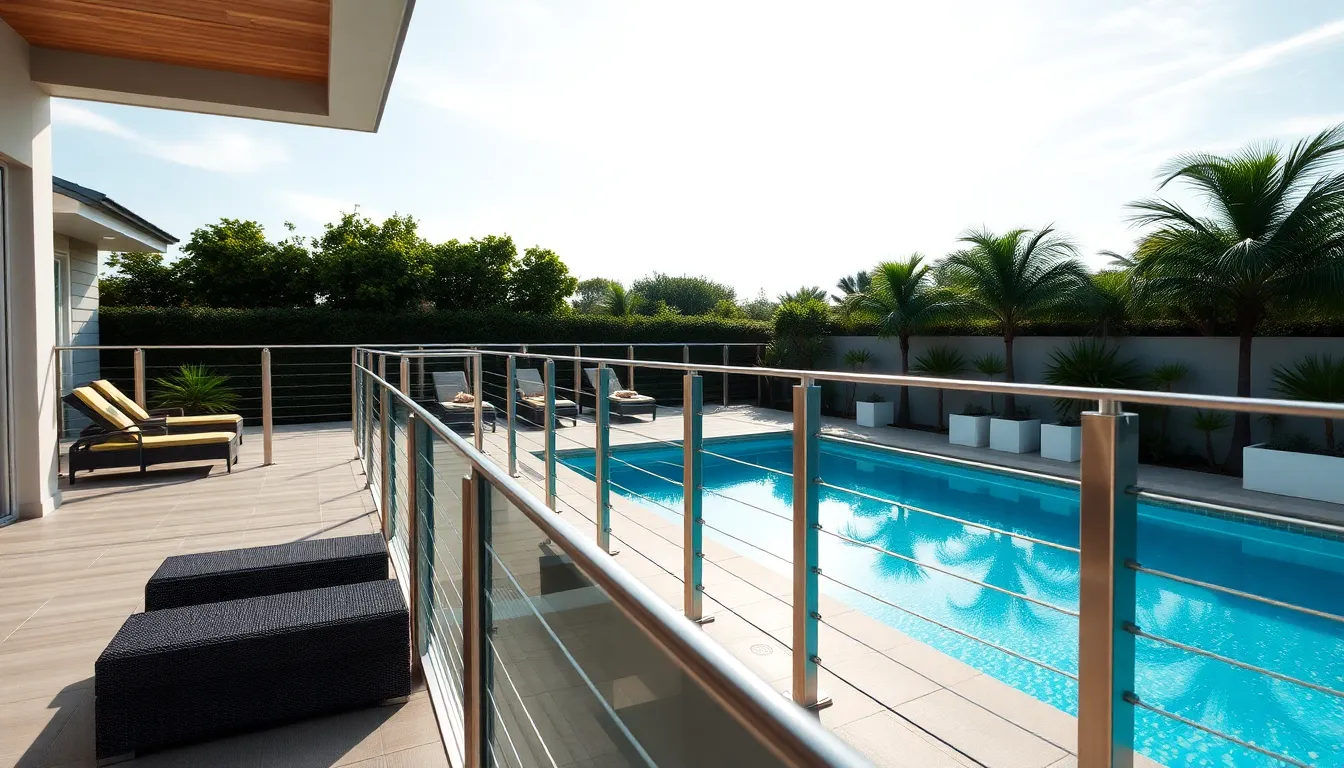
Cable railing systems transform pool deck areas with their minimalist design and unobstructed views. We’ve seen these systems become increasingly popular for contemporary and coastal designs due to their clean lines and exceptional durability in pool environments.
Stainless Steel Cable Configurations
Marine grade stainless steel cables form the backbone of these modern railing systems. We recommend this exact material because it resists corrosion from pool water and chemicals that would damage ordinary steel. These cables pair beautifully with aluminum, wood, or composite posts depending on your design preferences.
Different post materials offer unique aesthetic benefits while maintaining the sleek cable appearance. Aluminum posts provide a contemporary look that requires minimal maintenance. Wood posts add warmth and natural texture to complement outdoor settings. Composite materials offer the best of both worlds with wood like appearance and weather resistance.
Horizontal Cable Patterns
Horizontal cable configurations create the most popular and practical layout for pool deck railings. We position these cables to run parallel to your deck surface while maintaining proper spacing between vertical posts. This pattern maximizes visibility across your pool area while adding sophisticated modern appeal.
The horizontal design enhances safety by creating clear sight lines for pool supervision. Parents can easily monitor children in the water without visual obstruction. Alternative patterns like vertical or angled cables exist but we find horizontal configurations work best for most pool applications.
Cable Tensioning Systems
Proper cable tension ensures your railing system meets safety standards and withstands environmental stress. We install tensioners at end posts to keep cables taut and prevent dangerous sagging or vibration. Turnbuckles and mechanical tensioners allow for easy adjustments after installation.
Regular tension maintenance keeps your railing system compliant with local building codes. Weather changes and settling can affect cable tightness over time. We recommend checking tension levels annually and adjusting as needed to maintain optimal performance and safety standards.
Traditional Aluminum Railing Designs
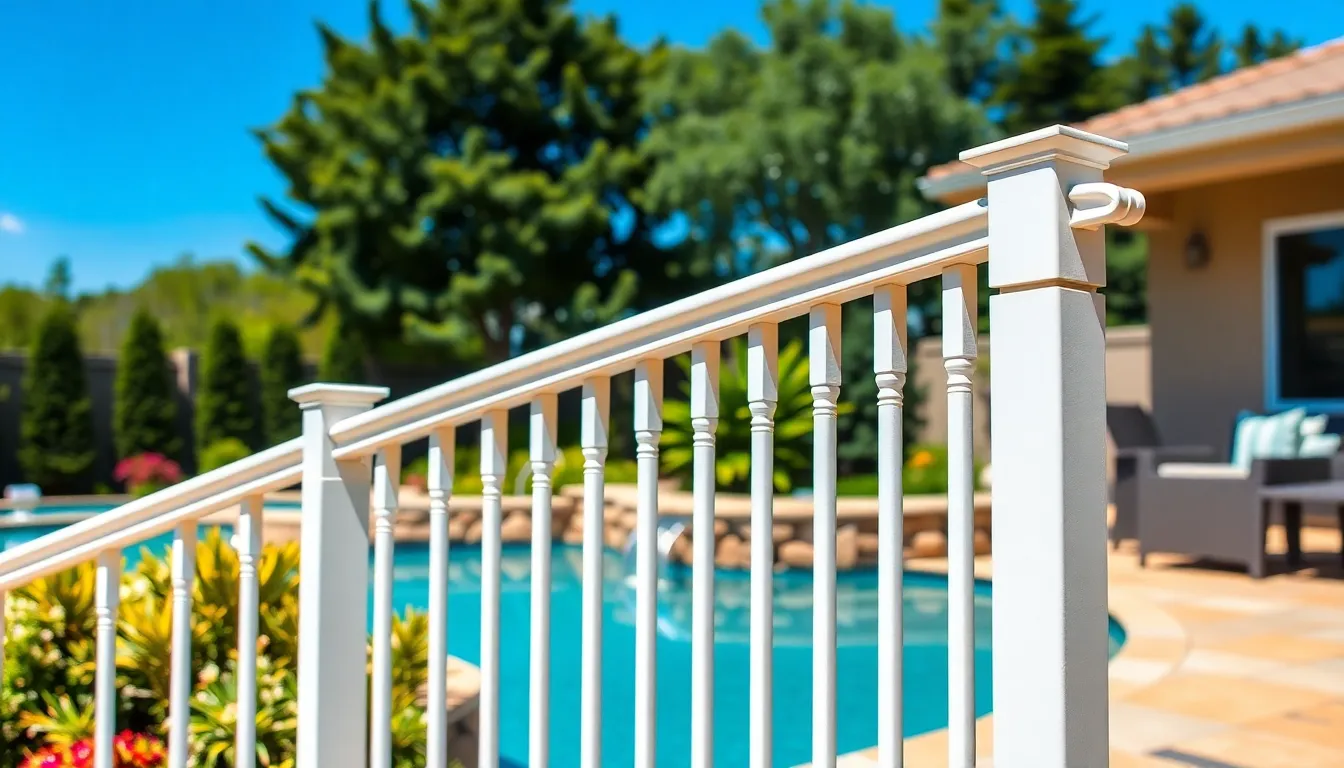
We turn to aluminum railings for their timeless appeal and versatility across various architectural styles. These classic designs feature clean vertical balusters and elegant post caps that seamlessly complement craftsman, modern, and traditional home designs.
Powder-Coated Aluminum Benefits
Powder coating transforms aluminum railings into pool deck champions that resist rust, fading, and chipping. This protective finish becomes essential when dealing with chlorine exposure, intense sunlight, and constant moisture around pool areas.
Our powder coated aluminum railings maintain their color integrity for years without the constant upkeep required by other materials. Multiple color options allow homeowners to customize their pool deck aesthetics while enjoying enhanced corrosion resistance compared to raw aluminum finishes.
Weather resistance improves dramatically with powder coating, making these railings ideal for outdoor pool environments where durability matters most. The finish creates a barrier that protects the underlying aluminum from environmental damage while maintaining its sleek appearance.
Decorative Aluminum Balusters
Decorative balusters elevate standard pool deck railings from functional barriers to stunning focal points. Custom shapes, intricate patterns, and specialized finishes allow homeowners to express their personal style while maintaining safety standards.
Craftsman style patterns bring traditional elegance to pool areas, while circular motifs add classical sophistication to the deck design. Modern geometric shapes create contemporary appeal that complements minimalist pool designs and architectural features.
Visual interest increases when decorative balusters incorporate unique metalwork designs that complement existing landscaping or pool features. These custom elements transform ordinary railings into conversation pieces that enhance the overall backyard aesthetic.
Maintenance-Free Aluminum Options
Aluminum railings require minimal upkeep compared to wood or wrought iron alternatives, especially when enhanced with protective finishes. They won’t warp, splinter, or corrode over time, eliminating the need for regular sanding, painting, or rust treatments.
Cleaning becomes effortless with simple soap and water applications that keep aluminum railings looking fresh and new. This low maintenance quality proves invaluable around pool decks where constant exposure to water and pool chemicals occurs.
Durability extends the lifespan of aluminum railings significantly, making them a cost effective investment for pool safety and aesthetics. Their resistance to environmental factors ensures consistent performance and appearance throughout years of pool seasons.
Sleek Stainless Steel Railing Ideas
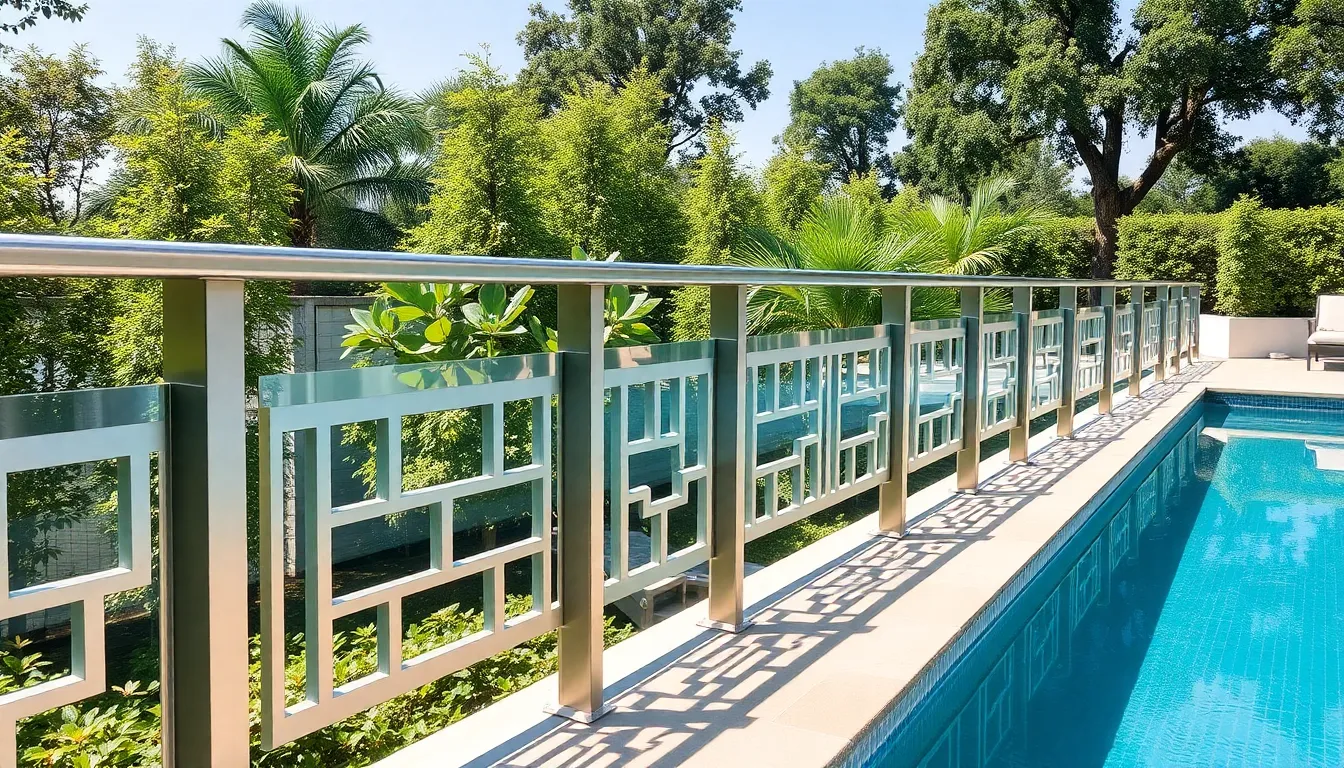
Stainless steel railings bring a sophisticated modern edge to pool deck designs with their slim profiles and metallic finish. These contemporary systems create clean lines that complement today’s outdoor aesthetics while improving your pool area’s visual appeal.
Brushed Stainless Steel Finishes
Brushed stainless steel finishes offer a refined texture with a soft matte sheen that dramatically reduces glare compared to polished surfaces. We recommend this finish for its practical benefits, as it effectively hides fingerprints and minor scratches that occur with regular use. This elegant yet understated appearance creates an upscale look that’s perfect for modern pool settings. Brushed finishes blend functionality with style, providing the sophisticated aesthetic you want without the high maintenance requirements of mirror-polished surfaces.
Contemporary Geometric Patterns
Contemporary geometric patterns transform standard stainless steel railings into artistic architectural features that enhance your pool deck’s visual interest. These designs include intersecting horizontal and vertical slats, stair-step configurations, and square or rectangular motifs that create ever-changing shadows throughout the day. Geometric elements add decorative appeal without overwhelming your outdoor space, striking the perfect balance between form and function. We’ve seen these patterns work exceptionally well in modern and minimalist pool designs where they serve as sculptural elements that complement the water feature.
Corrosion-Resistant Properties
Corrosion resistance stands as the primary advantage of stainless steel railings in pool environments where humidity and chlorine exposure create challenging conditions. Stainless steel withstands rust and degradation far better than traditional metals, ensuring your investment maintains its appearance and structural integrity over time. This exceptional durability translates to lower maintenance requirements and reduced replacement costs compared to other railing materials. We particularly value this feature for poolside applications where the combination of moisture, chemicals, and temperature fluctuations would quickly compromise lesser materials.
Natural Wood Railing Concepts
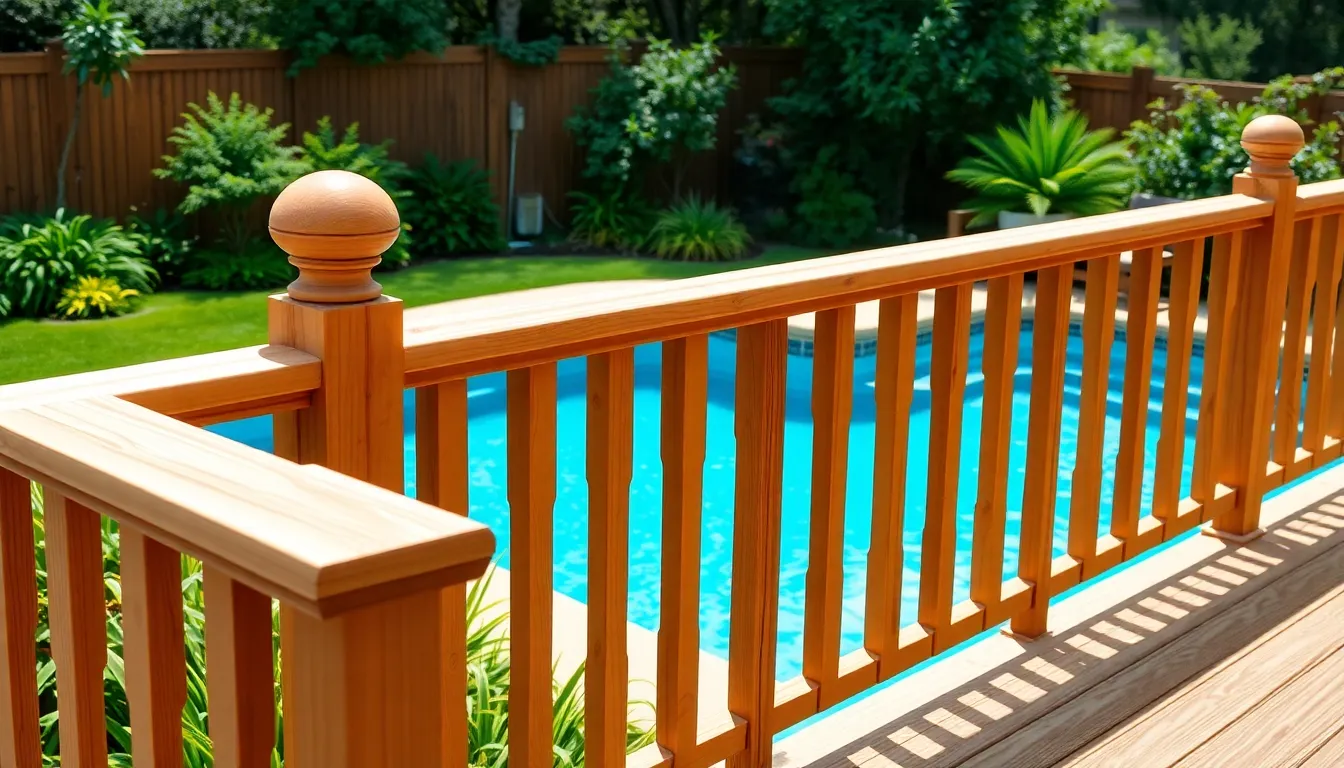
Natural wood railings bring warmth and timeless elegance to pool deck designs while creating a seamless connection with outdoor surroundings. We’ll explore the most popular wood options and maintenance strategies that ensure your railing investment delivers both beauty and durability.
Cedar Deck Railing Options
Cedar railings offer exceptional value for pool deck applications due to their natural resistance to moisture, decay, and insect damage. The wood’s appealing reddish tone creates an attractive focal point that weathers beautifully over time, developing character while maintaining structural integrity.
Popular cedar railing designs include:
- Vertical balusters with double top rails
- Horizontal wood slat configurations
- Privacy panel installations
- Cable infill styles with cedar posts
Cedar’s natural oils reduce the need for frequent chemical treatments compared to other wood species. We recommend cedar for homeowners seeking a balance between affordability and performance in humid pool environments.
Teak Pool Deck Applications
Teak represents the premium choice for pool deck railings thanks to its high oil content that provides exceptional water resistance and weathering durability. This upscale material features a rich golden brown color that adds sophisticated elegance to any poolside setting.
Key advantages of teak railings:
- Superior moisture resistance prevents warping and splitting
- Minimal maintenance requirements beyond occasional cleaning
- Natural aging to distinguished silver patina if left untreated
- Excellent performance in humid, chlorinated environments
Teak railings pair beautifully with metal or glass elements to create modern pool deck aesthetics. We find teak performs exceptionally well in coastal areas where salt air challenges other materials.
Wood Staining and Sealing Tips
Proper staining and sealing protect wood railings from pool chemicals, UV exposure, and moisture infiltration. We recommend following these essential maintenance practices to maximize your wood railing lifespan:
Critical maintenance steps:
| Maintenance Task | Frequency | Key Requirements |
|---|---|---|
| Stain application | Every 1-3 years | High-quality exterior stain with UV protection |
| Sealant renewal | Every 1-3 years | Water-repellent formulation |
| Cleaning | Seasonally | Mild detergent, avoid harsh chemicals |
Best practices for wood protection:
- Choose semi transparent stains to showcase natural grain while providing protection
- Apply products during moderate temperatures with low humidity
- Clean railings thoroughly before applying new finishes
- Test stain colors on inconspicuous areas first
Regular upkeep preserves wood’s natural beauty while improving durability against the challenging pool environment. We emphasize that consistent maintenance schedules prevent costly repairs and extend railing life significantly.
Composite Railing Material Choices
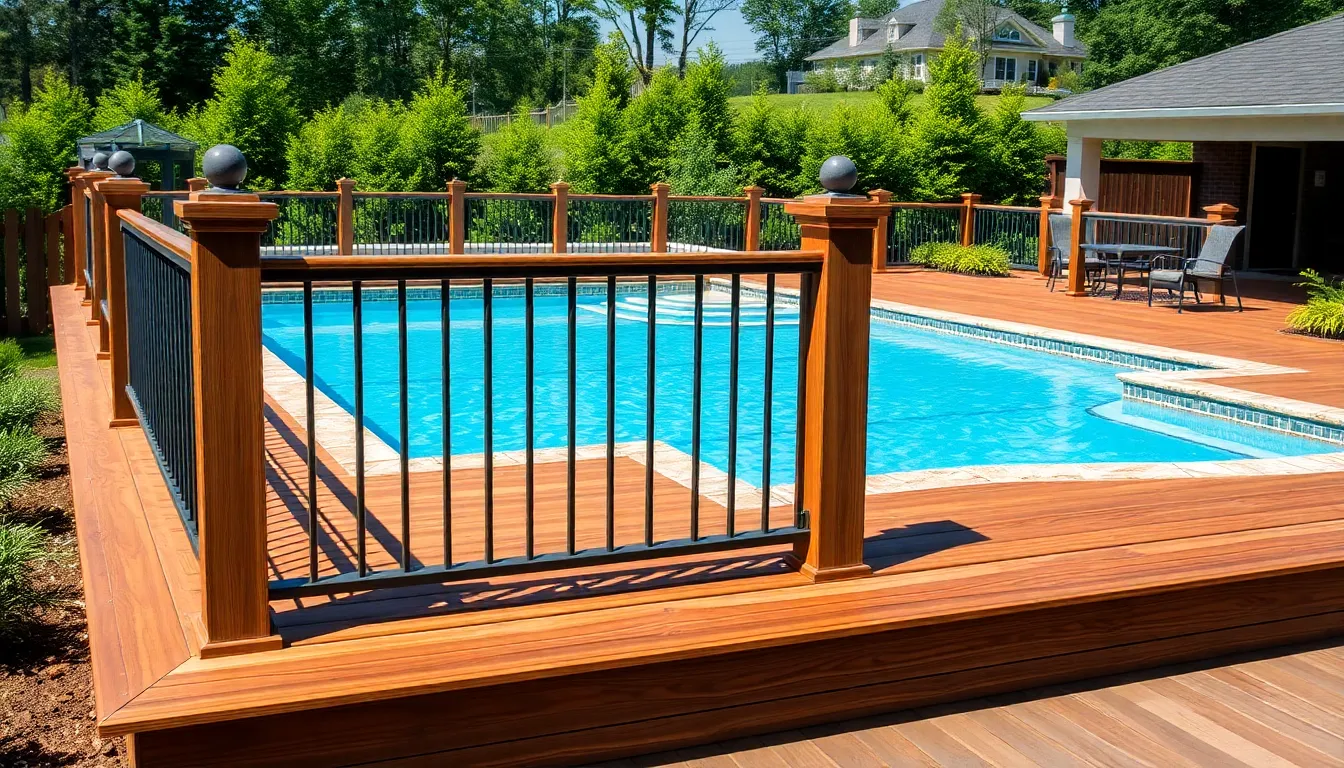
Composite railings represent a revolutionary approach to pool deck design, combining high-performance polymers with recycled wood fibers to create stunning barriers that rival traditional materials. We’ve found these innovative systems deliver the natural beauty of wood while eliminating the maintenance headaches that come with moisture-rich pool environments.
Low-Maintenance Composite Benefits
Composite railings require virtually no upkeep compared to traditional wood options, making them perfect for busy homeowners who want beautiful pool decks without constant maintenance demands. Unlike wood railings that rot, warp, or splinter over time, composite materials maintain their structural integrity and appearance year after year. We recommend composite systems because they never need seasonal staining, painting, or protective treatments that traditional materials require.
Cleaning composite railings takes just minutes with basic soap and water, eliminating the need for specialized chemicals or expensive maintenance services. Pool chemicals and chlorine exposure won’t damage composite surfaces, unlike wood that can deteriorate when exposed to harsh pool environments. Composite materials resist fading from UV exposure, ensuring your railing maintains its vibrant color without requiring touch-ups or refinishing treatments.
Color-Matching Composite Options
TimberTech and other leading manufacturers offer extensive color palettes designed to seamlessly match existing decking materials and outdoor furniture pieces. We’ve seen homeowners create cohesive pool environments by selecting composite railings that perfectly complement their deck boards and surrounding industry features. Color options range from rich browns and warm grays to contemporary blacks and crisp whites, supporting every design aesthetic from traditional to ultra-modern styles.
Custom color matching allows property owners to coordinate their entire pool area, creating visual harmony between railings, decking, and architectural elements. Multi-tone composite options provide sophisticated depth and texture that mimics natural wood grains without the associated maintenance requirements. Manufacturers often provide color samples and design consultations to ensure perfect aesthetic integration with existing pool deck materials.
Durability in Pool Environments
Pool environments present unique challenges that composite materials handle exceptionally well, offering superior resistance to moisture, chlorine, and salt exposure compared to traditional railing options. Composite railings won’t absorb water like wood materials, preventing common poolside problems such as mold growth, mildew formation, and structural decay. We’ve observed that composite systems maintain their strength and appearance even after years of exposure to pool chemicals and high humidity conditions.
TimberTech’s Tri-Layer Technology™ and similar proprietary manufacturing processes optimize composite strength and rigidity specifically for outdoor applications near water features. Aluminum infill panels can be integrated with composite frames to enhance corrosion resistance while maintaining modern aesthetic appeal. These hybrid designs provide long-term structural integrity that’s essential for pool safety barriers, ensuring your investment delivers both beauty and protection for decades to come.
Wrought Iron and Metal Ornamental Styles
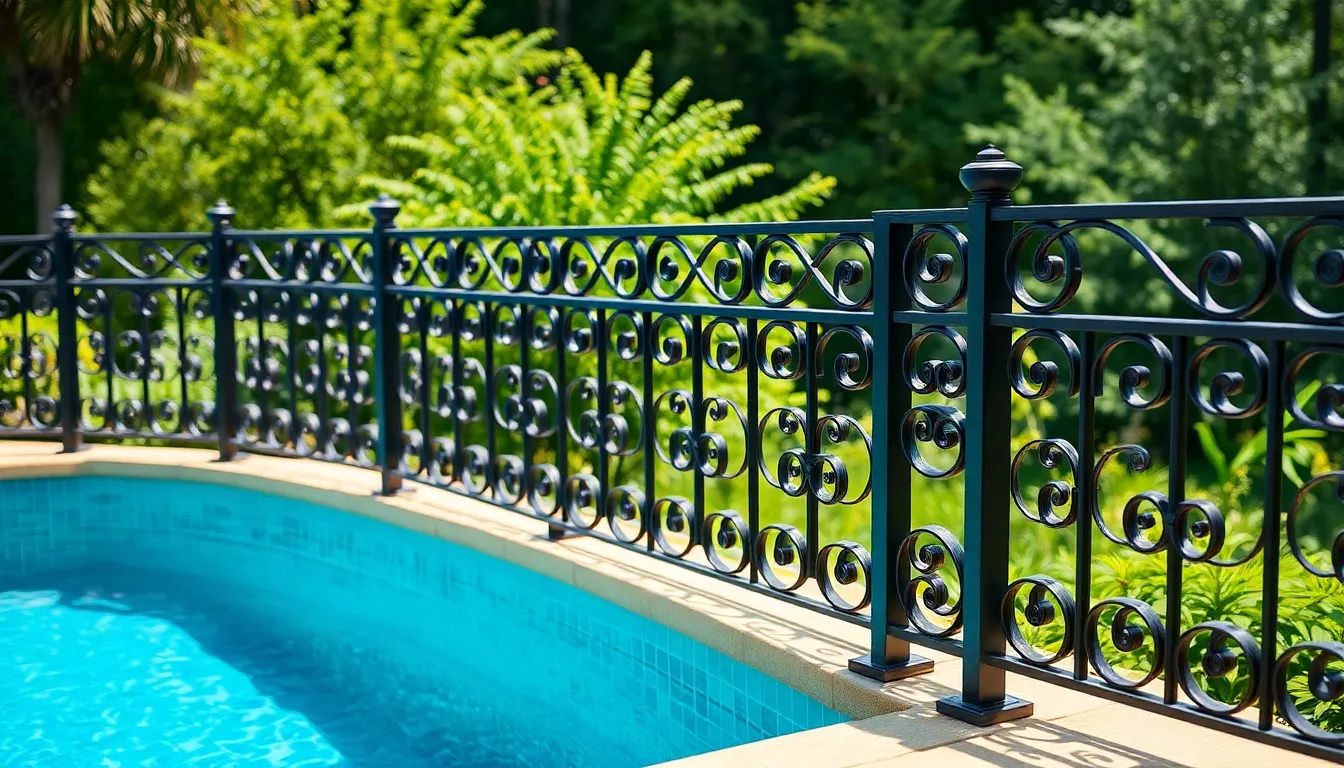
Wrought iron and metal railings deliver unmatched durability while adding sophisticated elegance to your pool deck design. These ornamental styles range from simple vertical balusters to intricate patterns that transform functional safety barriers into stunning architectural features.
Custom Ironwork Designs
Custom ironwork enables us to create personalized railing designs that perfectly complement your pool’s unique shape and surrounding architecture. Heat bending techniques allow craftsmen to curve metal balusters that follow circular or oval pool contours, creating seamless visual flow throughout your outdoor space.
Intersecting horizontal and vertical metal slats can be arranged in stair-step or grid-like formats to produce striking custom panels. Modern elements like gradient spacing of balusters or alternating panel orientations add visual engagement while maintaining essential safety functions.
Curved balusters and double top rails offer sophisticated alternatives to standard designs, while decorative circles or squares integrated into railing panels provide geometric interest. Wave-shaped or waterfall-motion balusters create ever-changing artistic effects that capture the fluid nature of your pool environment.
Powder Coating for Weather Protection
Powder coating provides essential long-lasting protection against rust, corrosion, and fading that can compromise metal railings over time. This durable finish creates a uniform barrier that maintains your railing’s aesthetic appeal while significantly reducing maintenance requirements in harsh outdoor conditions.
Multiple color and finish options become available through powder coating, enabling you to match or complement your existing pool deck design perfectly. Sun exposure, moisture, and pool chemicals pose constant threats to unprotected metal surfaces, making this protective coating especially crucial for poolside installations.
Weather-related damage becomes virtually eliminated when quality powder coating is properly applied to wrought iron and metal railings. Maintenance costs drop substantially compared to traditional paint finishes that require frequent touch-ups and reapplication.
Traditional Scrollwork Patterns
Traditional scrollwork incorporates decorative curved motifs featuring spirals, vines, and floral elements that create timeless visual appeal. These patterns add ornamental richness when combined with straightforward balusters, achieving the perfect balance between elegance and safety compliance.
Historical design elements lend vintage or Mediterranean character to pool decks, improving their architectural charm and creating sophisticated outdoor living spaces. Craftsman-style metal railings with alternating baluster widths and geometric patterns provide architectural interest that complements various home styles.
Scrollwork details can be customized to reflect your personal taste while maintaining the classic aesthetic that makes wrought iron railings so enduringly popular. Spiral motifs and vine patterns create visual texture that catches light beautifully throughout different times of day.
Mixed Material Railing Combinations
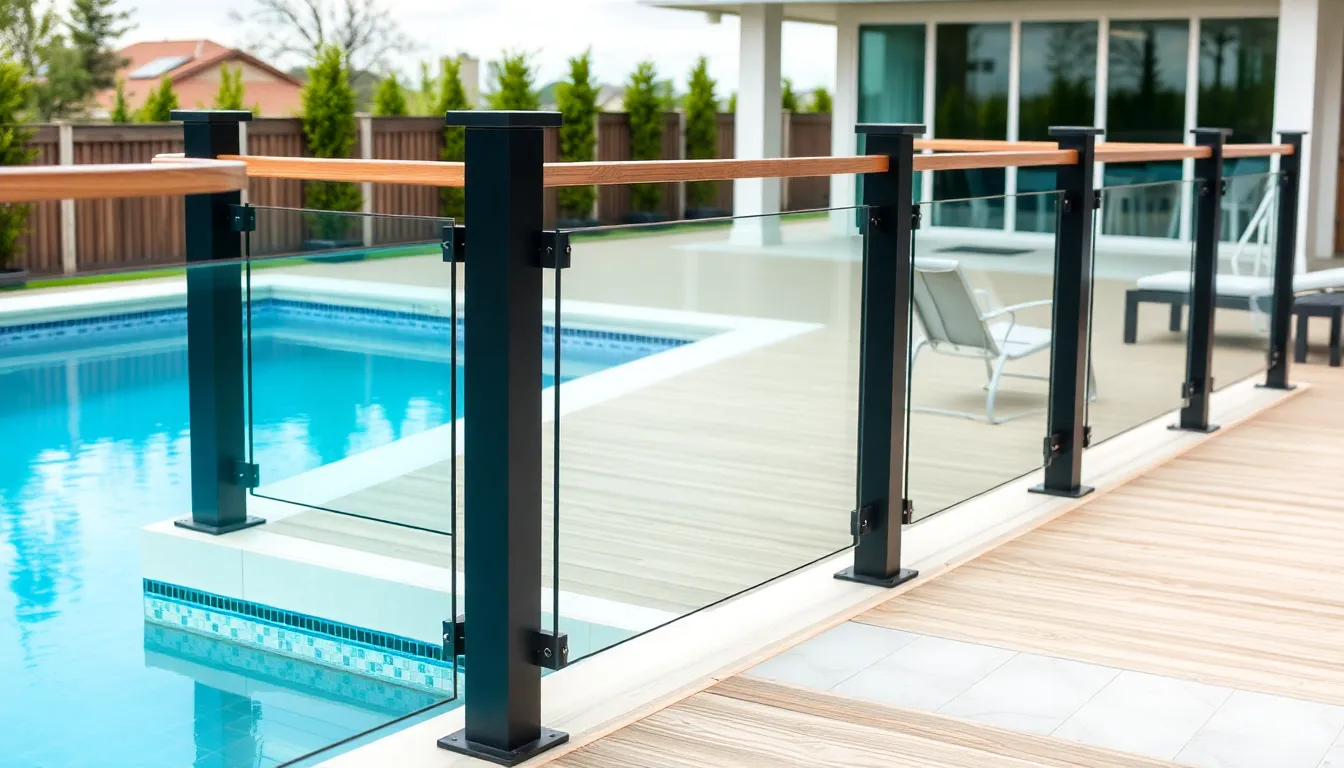
Creative pool deck designs reach their full potential when we combine different materials to create stunning visual contrasts and enhanced functionality. These innovative approaches deliver both aesthetic appeal and superior performance for modern outdoor spaces.
Wood and Metal Hybrid Designs
Wood and metal combinations create stylish railings that blend natural warmth with industrial strength for pool environments. Metal posts paired with wooden top rails offer visual contrast while delivering enhanced stability across various architectural styles from rustic to modern designs. Black metal posts connected by vertical balustrades and capped with tropical hardwood handrails exemplify this hybrid approach perfectly.
Contemporary looks emerge when we use wood posts with horizontal metal slats, creating clean lines that complement modern pool decks. These designs suit multiple architectural styles while providing the durability needed for pool environments. Metal components handle structural loads while wood elements add warmth and natural beauty to the overall design.
Glass and Steel Integration
Glass panels paired with steel or aluminum frames deliver sleek, minimalistic options that preserve unobstructed pool views while maximizing natural light. Tempered glass railing systems with steel supports have become increasingly popular for modern pool decks, providing essential safety without sacrificing style or sightlines. Multi level decks benefit significantly from glass railings applied to stairs and platforms, adding elegance and openness to outdoor spaces.
Dark wood decks create refined balance when complemented by white trimmed glass and steel railings, blending rustic and modern elements seamlessly. These combinations work particularly well in contemporary settings where maintaining visual flow between indoor and outdoor spaces is crucial. Steel frames provide structural integrity while glass panels ensure unimpeded views of pool activities.
Stone Column Accent Features
Stone columns incorporated as accents within railing systems add substantial texture and a sense of permanence to pool deck designs. These architectural elements can anchor wood or metal railings effectively, providing sturdy visual focal points that harmonize with natural surroundings or complement nearby stone features like walls or patios. Craftsman style and rustic designs particularly benefit from stone column integration.
Paired combinations of stone columns with wood and metal elements enhance both architectural character and overall durability of pool deck railings. These designs create strong visual anchors that ground the entire railing system while adding sophisticated detail. Stone elements require minimal maintenance while providing lasting structural support and aesthetic appeal that withstands pool environment challenges.
Safety Code Compliance Considerations
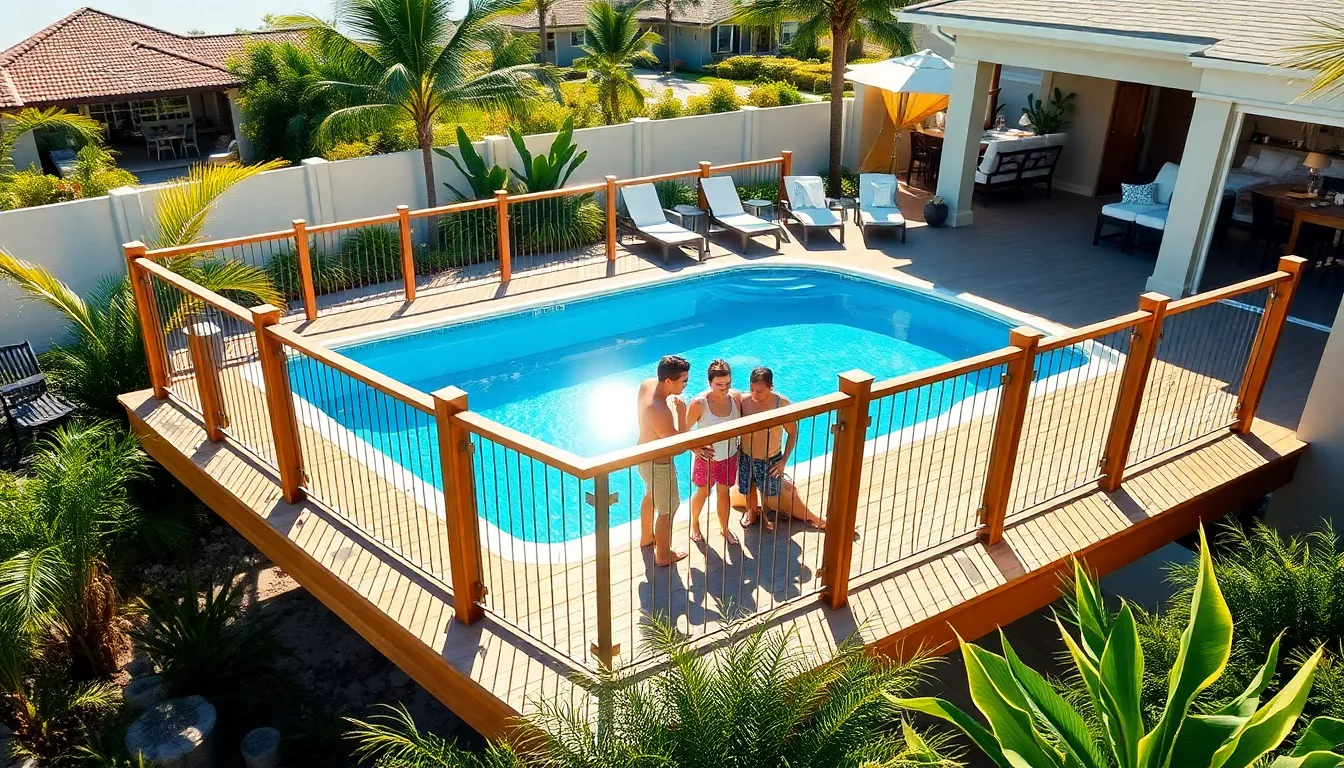
Pool deck railings must meet established safety codes to protect your family and guests while avoiding costly compliance issues. We’ll guide you through the essential requirements that govern railing installations around pool areas.
Height Requirements for Pool Areas
General deck railings require a minimum height of 36 inches above the deck surface, particularly for decks positioned more than 30 inches above ground level according to the International Residential Code (IRC).
California mandates stricter requirements with 42-inch railings around pool decks and elevated areas, reflecting the state’s enhanced safety standards for residential properties.
Pool barrier codes often specify 48-inch heights to effectively restrict unauthorized access to swimming areas, especially for dedicated pool enclosures that serve as primary safety barriers.
Local jurisdictions frequently impose additional height requirements beyond federal guidelines, making it essential to verify exact regulations in your area before beginning installation.
Spacing Standards for Balusters
Baluster spacing cannot exceed 4 inches between vertical elements to prevent children from squeezing through openings, including the critical gap between bottom rails and deck surfaces.
Stair railings require triangular openings formed by treads, risers, and bottom rails to restrict passage of spheres larger than 6 inches in diameter.
Post spacing typically limits to 8 feet maximum intervals to maintain structural integrity and meet load bearing requirements specified in building codes.
Infill panels must undergo testing to resist 125 pounds of pressure across one square foot areas, while top rails need to sustain concentrated loads of 500 pounds at mid span points.
Local Building Code Variations
Building departments impose varying requirements that often exceed International Residential Code minimums, with some municipalities requiring enhanced load testing standards for pool environments.
Pool exact barriers demand higher railings than general deck requirements, typically mandating 48-inch heights compared to standard 36-inch guardrails for non-pool applications.
Coastal areas frequently require upgraded materials and testing protocols due to increased exposure to salt air and moisture that can compromise standard railing systems.
Permit applications must include detailed specifications showing compliance with local codes, including structural calculations and material certifications that meet jurisdiction requirements.
Installation and Maintenance Tips
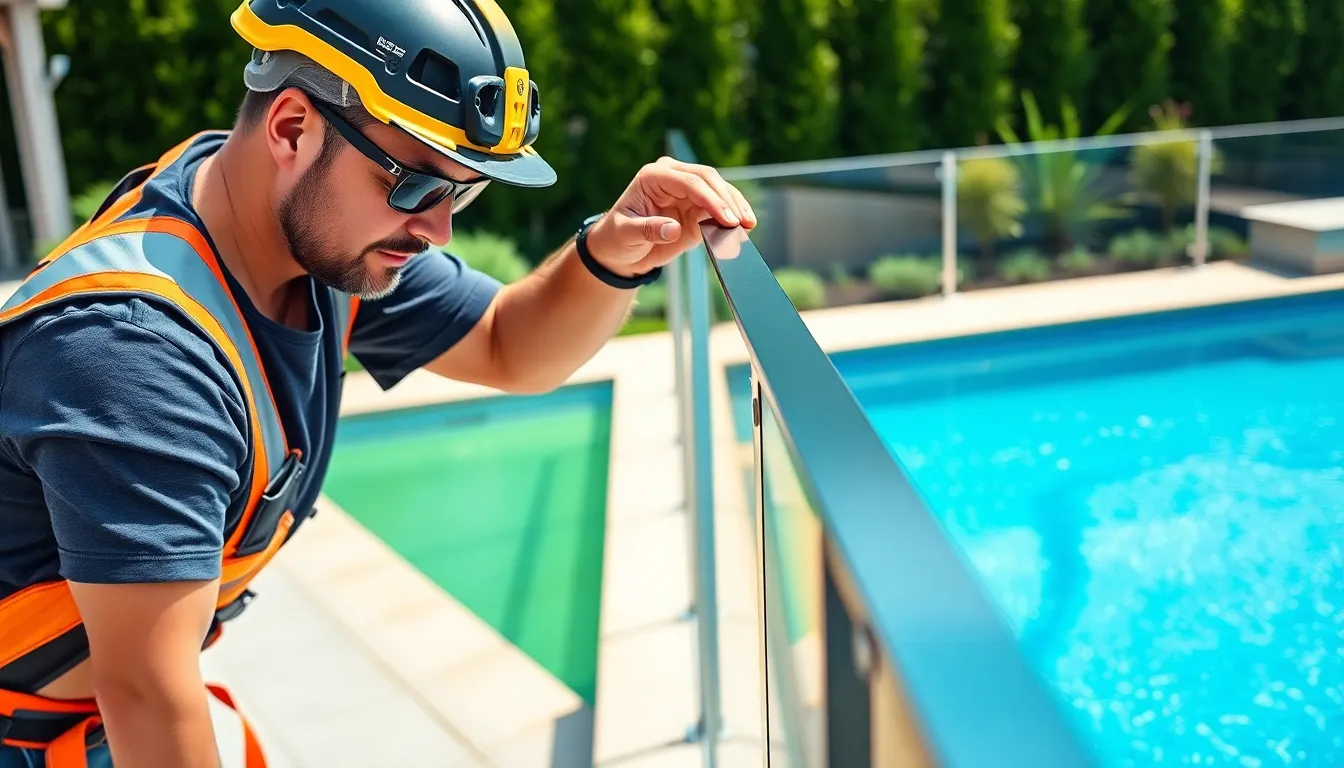
Proper installation and ongoing maintenance play crucial roles in maximizing your pool deck railing’s safety, durability, and aesthetic appeal. We’ll explore the key considerations for both professional and DIY approaches, plus essential care requirements to keep your railing system performing optimally.
Professional Installation Benefits
Compliance with safety codes becomes guaranteed when we choose professional installation services. Expert installers understand local building regulations and ensure your railing meets all height, spacing, and structural requirements that vary by jurisdiction.
Structural anchoring expertise provides the foundation for long lasting durability around pool environments. Professional teams use corrosion resistant hardware and proper techniques to secure railings into deck structures, preventing safety hazards from improper mounting.
Aesthetic appeal reaches its full potential through professional finishing techniques that enhance both functionality and visual impact. Skilled installers deliver precise measurements, level installations, and clean joints that elevate your pool deck’s overall appearance.
Warranty coverage typically accompanies professional services, protecting your investment against installation defects and providing liability protection. Most professional installers include comprehensive warranties that cover both materials and workmanship for extended periods.
DIY Installation Considerations
Experience requirements make DIY installation suitable primarily for handypersons with precise measurement skills and proper tool access. We recommend this approach only when you’re comfortable with structural work and have experience with similar projects.
Railing kit selection becomes critical for successful DIY projects, requiring systems designed specifically for easy assembly with clear instruction manuals. Choose kits that include all necessary hardware and provide step by step guidance for your exact material type.
Safety risks include improper anchoring that can lead to structural failure, voided manufacturer warranties, and potential non compliance with local building codes. These risks can result in costly corrections and potential liability issues if accidents occur.
Time investment typically exceeds expectations for DIY installations compared to professional services. Factor in additional effort for research, tool acquisition, and potential troubleshooting during the installation process.
Long-Term Care Requirements
Material exact maintenance varies significantly based on your railing choice, with aluminum and composite requiring minimal upkeep while wood needs seasonal attention. Clean aluminum and metal systems periodically and inspect for corrosion, while wood railings require regular staining or sealing to protect against moisture and sun damage.
Regular inspections should focus on loose fasteners, structural damage, and wear patterns, especially after winter weather or storms. Check all connection points and hardware for signs of corrosion or loosening that could compromise safety.
Debris reduction benefits make proper railing maintenance worthwhile, as well maintained barriers help prevent debris from blowing into your pool area. This secondary benefit reduces your overall pool cleaning effort and maintenance costs.
Component replacement becomes necessary over time for worn parts like balusters, caps, and fasteners to maintain both safety and appearance standards. Plan for periodic refinishing or repainting of wood railings to prevent deterioration and extend system lifespan.
Conclusion
We’ve explored an extensive range of pool deck railing options that can transform your backyard into a stunning and safe retreat. From sleek glass panels that maintain unobstructed views to durable aluminum systems that require minimal maintenance each material offers unique advantages for different design preferences and budgets.
Remember that your perfect railing solution depends on your exact needs including local climate conditions architectural style and maintenance preferences. Whether you choose modern stainless steel contemporary cable systems or warm natural wood the key is selecting materials that complement your pool area while meeting all safety requirements.
We encourage you to consult with local professionals to ensure proper installation and code compliance. With the right railing choice you’ll create a beautiful functional space that enhances both your property value and your family’s enjoyment for years to come.
Frequently Asked Questions
What are the most popular pool deck railing materials?
The most popular pool deck railing materials include glass panels, aluminum, stainless steel, cable wire systems, natural wood (cedar and teak), composite materials, and wrought iron. Each material offers unique benefits: glass provides unobstructed views, aluminum is low-maintenance, stainless steel offers modern aesthetics, cable systems create minimalist designs, wood adds natural warmth, composite requires minimal upkeep, and wrought iron provides elegant durability.
How high should pool deck railings be according to building codes?
Pool deck railings must be at least 36 inches high according to general building codes. However, some areas like California require 42-inch heights for enhanced safety. Local building codes may have additional requirements, so it’s essential to verify regulations in your area before installation. These height requirements ensure proper safety barriers around pool areas and prevent accidents.
What makes tempered glass ideal for pool deck railings?
Tempered glass is ideal for pool deck railings because it’s 4-5 times stronger than regular glass and shatters into small, harmless pieces when broken. It uses 12mm thick panels that withstand significant wind loads and resist pool chemicals. Tempered glass is easy to maintain, provides unobstructed views, and meets building code requirements for pool safety barriers.
How do I maintain wood railings around my pool?
Wood railings require regular staining and sealing to protect against pool chemicals, UV exposure, and moisture. Clean railings annually and reapply protective finishes every 2-3 years. Choose naturally resistant woods like cedar or teak for better durability. Regular maintenance prevents decay, preserves appearance, and extends the railing’s lifespan, ultimately saving money on costly repairs.
What are the benefits of cable wire railing systems?
Cable wire railing systems offer minimalist design with unobstructed views, making them perfect for pool supervision. They feature marine-grade stainless steel cables that resist corrosion in pool environments. These systems work well with various post materials like aluminum, wood, or composite, providing design flexibility while maintaining clean lines and contemporary aesthetics.
Do I need professional installation for pool deck railings?
Professional installation is highly recommended for pool deck railings to ensure safety code compliance, proper structural anchoring, and warranty coverage. Professionals have expertise in local regulations and installation techniques. While DIY installation is possible with railing kits, it requires experience and knowledge of safety requirements. Improper installation can lead to safety hazards and code violations.
How do composite railings perform in pool environments?
Composite railings excel in pool environments due to their resistance to moisture, chlorine, salt, and UV exposure. They combine recycled wood fibers with high-performance polymers, requiring virtually no maintenance compared to traditional wood. Composite materials maintain structural integrity and appearance over time, resist pool chemicals, and offer easy cleaning with simple soap and water.
What maintenance do aluminum railings require?
Aluminum railings require minimal maintenance, making them ideal for pool areas. Powder-coated aluminum resists rust, fading, and chipping. Simply clean with soap and water periodically to remove dirt and pool chemicals. Unlike wood or wrought iron, aluminum railings don’t need regular painting, staining, or rust treatment, making them a cost-effective, low-maintenance investment.
Can I mix different materials in my pool deck railing?
Yes, mixing materials creates unique, functional designs. Popular combinations include wood and metal hybrids for natural warmth with industrial strength, glass and steel integrations for sleek aesthetics, and stone columns as accent features. Mixed material designs enhance architectural character while ensuring durability and can be customized to match your pool deck’s style and requirements.
What spacing is required between railing balusters?
Baluster spacing must not exceed 4 inches between vertical elements to prevent children from slipping through openings. This standard applies to all railing systems, whether using traditional balusters, cable systems, or glass panels. Proper spacing ensures safety compliance and prevents accidents while maintaining the railing’s aesthetic appeal and structural integrity.

